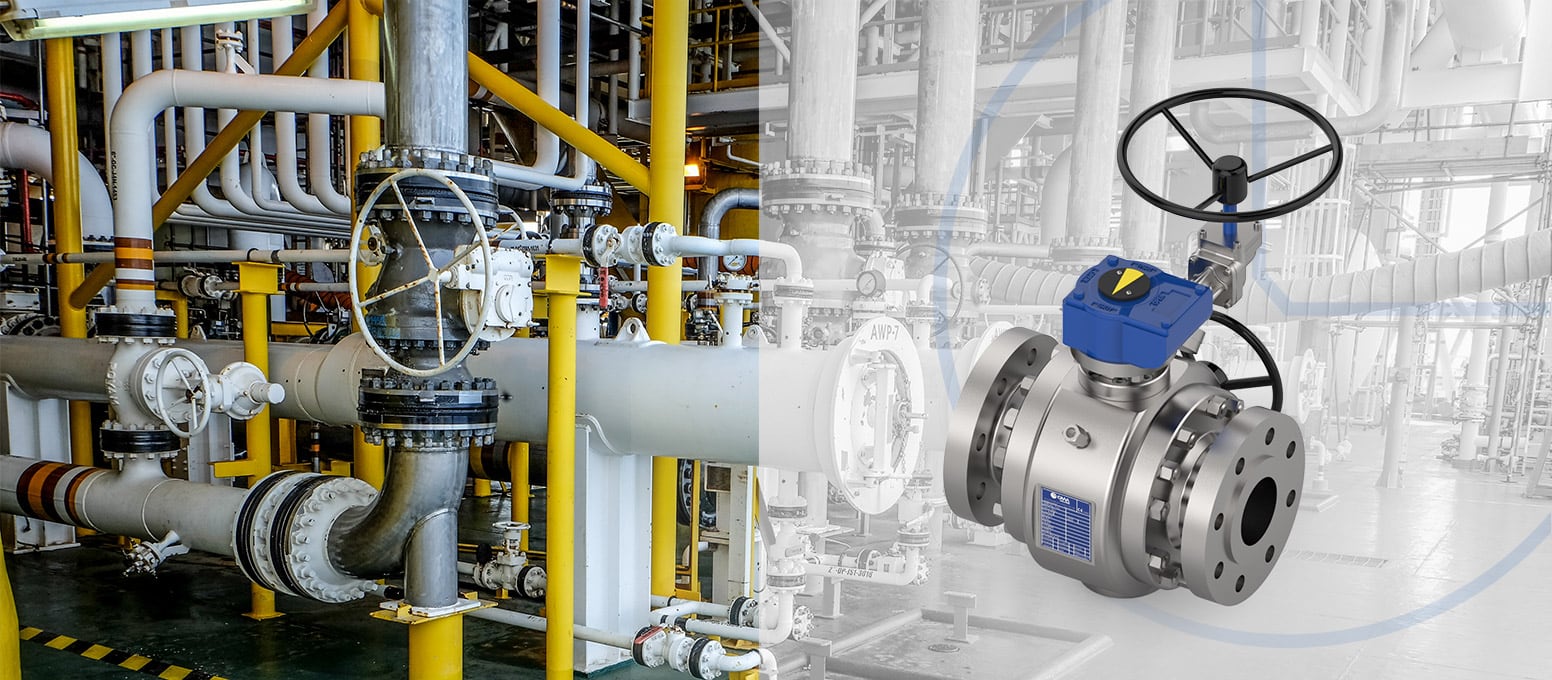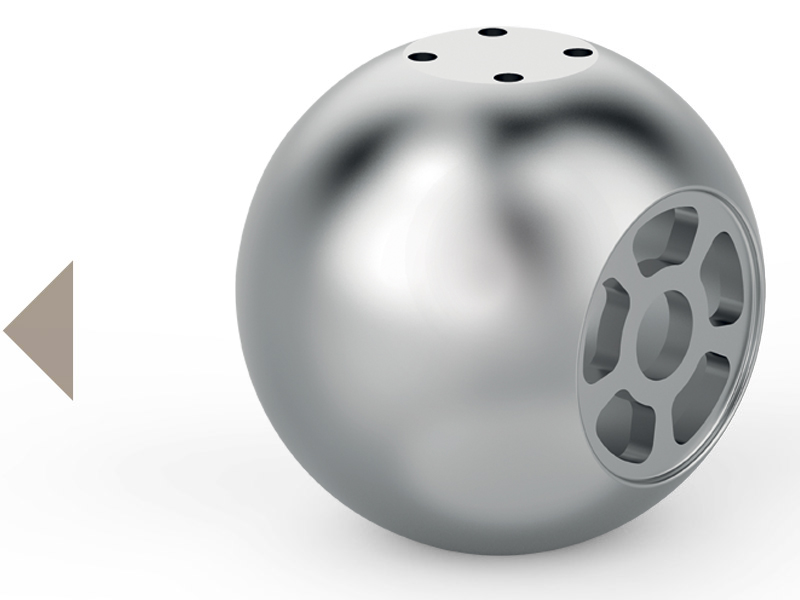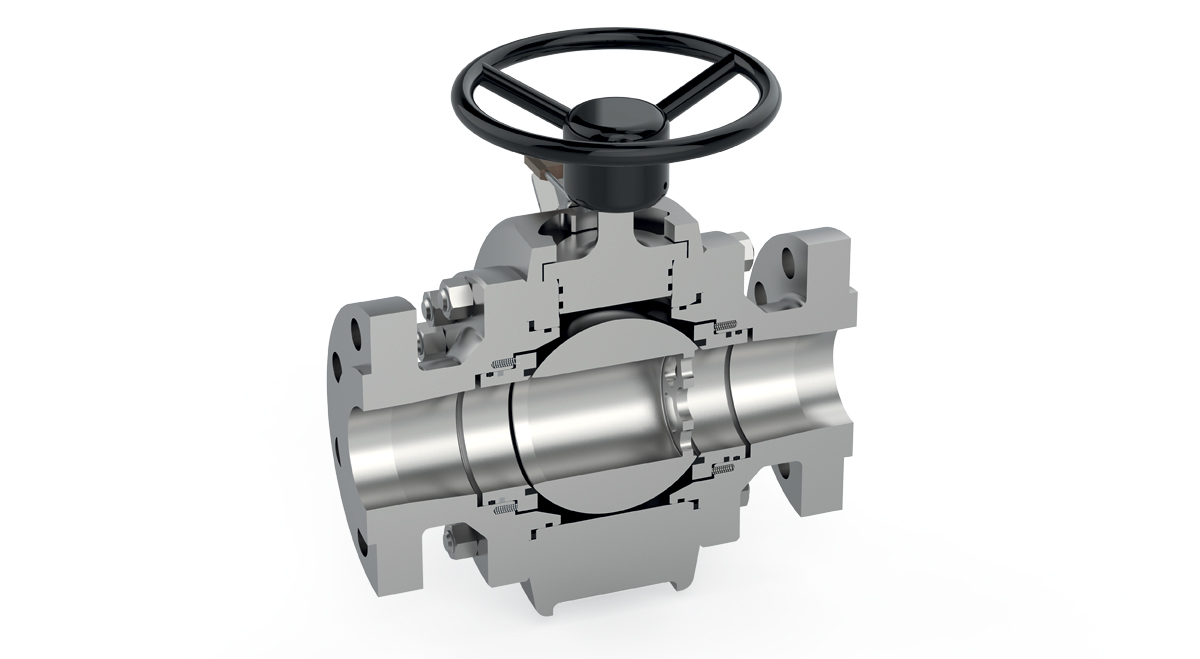- Valves division
- Pigging Valves
BENEFITS
- Trunnion Block design offers reduced torque and robustness
- Complete Range of Fluid flexibility and compatibility
- Cost savings over conventional pigging systems and skids
- Available as a Launcher, Receiver, or Catcher.
- Forged construction reduces NDE requirements
- Complete selection of pigging systems and accessories
DESIGN
- Engineered, manufactured and tested to API 598 / API 6D
- Industry Standards: API 6D, ASME B16.34 and API 598
- Face to face: API6D / ASME16.10
- Flange end: ASME B16.5 / ASME B16.47
- Butt-welding end: ASME B16.25
- Test: Fire safe: API607 / API6FA
- Meets NACE MR0175-03
FEATURES
- Positive Shut Off
- Trunnion Block mounted Ball for reduced torque and stem loading
- Large Bearings for smooth robust operation
- Up Stream sealing with automatic downstream cavity relief
- Double Block and Bleed with vent and drain capabilities
- Large button head grease fittings with buried checks
- Emergency seat sealant injection
- Pig Entry Cap with vent
- Pig Entry Cap with hex drive and spanner drive options
- Large Actuator Mounting Pads and Stems
PIG LAUNCHING & RECEIVING SEQUENCE
LAUNCHING

1
Ensure the valve is in the closed position. Vent the body cavity with the bleed fitting on the Entry Cap.
After valve is vented, the body fittings may be opened to drain or flush the valve.

2
After venting the body cavity pressure, remove the entry cap and insert the pig through the opening.
CAUTION: When unscrewing, if gas or liquids start to emerge STOP! Screw Entry Cap back on and verify Step 1.

3
Stand facing the valve stem to insert the Pig.
NOTE:
- Install Pig conical side DOWN if flow is from left to right.
- Install Pig conical side UP if flow is from right to left.

4
Before re-installing the Entry Cap on the valve, inspect seal integrity. Then, after ensuring the bleed fitting and all body fittings are closed - open the valve to launch the pig.
RECEIVING

1
Verify valve is installed as a receiver pig valve with the catcher plate downstream of the flow.

2
When the pig is received, close the valve. Vent the body cavity chamber with the bleed fitting on the entry cap. After the valve is vented, the body fittings may be opened to drain or flush the valve, if necessary.

3
Inspect all seals on the Entry Cap to ensure seal integrity. Reinstall the Entry Cap on the valve. Ensure the bleed fitting and all body fittings are closed. Open valve.

4
NOTE: For easier operation, apply anti-seize to the ACME threads of the Entry Cap.
CAUTION: Always dispose of hazardous materials appropriately.
PIG VALVE ORIENTATION
CATCHER POSITIONS
LAUNCHER ORIENTATION
Launcher with or without catcher
Flow direction: left to right

RECEIVER ORIENTATION
Flow direction: left to right
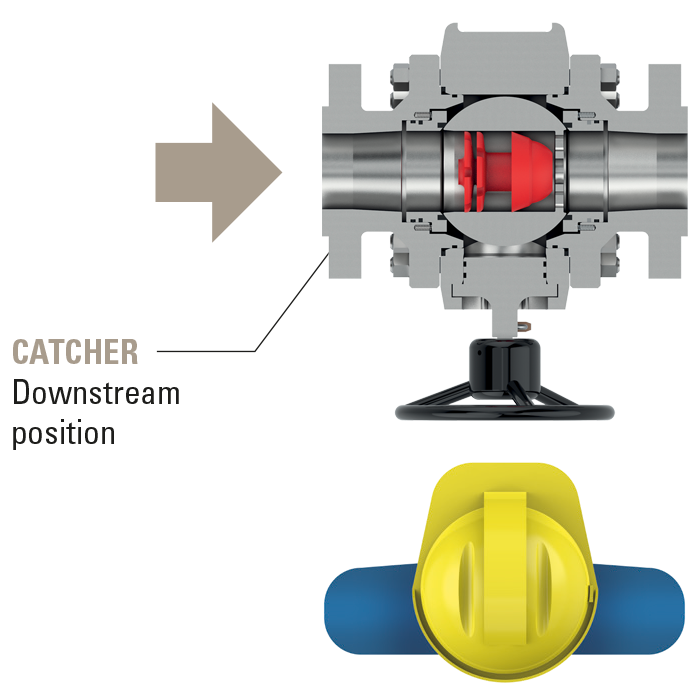
LAUNCHER ORIENTATION
Launcher with or without catcher
Flow direction: right to left

RECEIVER ORIENTATION
Flow direction: right to left
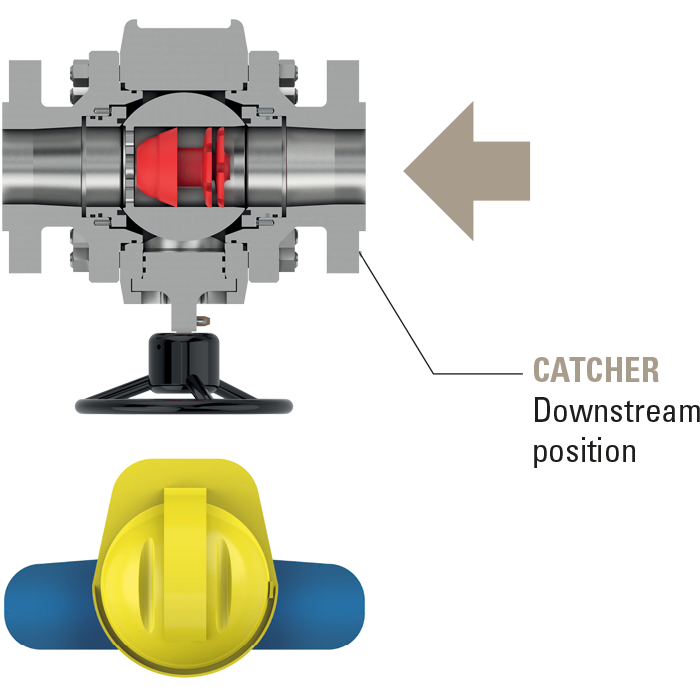
MATERIAL OPTIONS
CAM offers our Ball Valves in a variety of material options ensuring optimal performance in virtually any operating environment.
| PART NAME |
BILL OF MATERIALS |
| Body/End Connection |
Forged or Cast Carbons; Stainless Steels; Duplex |
| Ball |
A182 F6a; 316 SS; Duplex Alloys; Inconel™ and other Nickel Alloys |
| Seat |
A182 F6a; 316 SS; Duplex Alloys; Inconel™ and other Nickel Alloys; Stellite™, Devlon and PEEK |
| Body Seal |
HNBR, Viton, Aflas, Kalrez, and others |
| Seat Seal |
HNBR, Viton, Aflas, Kalrez, Garphite, and others |
| Stem |
A182 F6a; 316 SS; 17-4 PH SS; Inconel™ X750; Inconel™ 718 |
| Stem Seal |
HNBR, Viton, Aflas, Kalrez, Graphite, and others |
| Packing Gland |
A182 F6a; 304 SS; 316 SS |
CAM VALVE TECHNOLOGY
THE CAM VALVES SYSTEM UTILIZES A SIDE ENTRY SYSTEM OF SAFETY LATCHES FOR EASE OF ENTRY IN THE SAFEST POSSIBLE MANNER.
A completely revolutionary valve with patent pending technology that improves the accessibility to the central components for easy maintenance and repair. Our pig valve comes with several customization options to fit costumer needs.
Heavy duty Catcher Plates are constructed for longevity. The ability to vary the flow pattern through the Plate allows for optimal performance in a variety of services including liquids and solids containing streams.
TAKE A LOOK INSIDE
- Forged Body - Provides structural integrity.
- Ball - Maximized sealing surface for reliable isolation.
- Catcher Plate - Prevents overtravel of Pig and contains it in the bore of Ball
- Seat - Provides a perfect seal.
- Body Seal - Prevents leakage to atmosphere. Variety of materials available to suit application.
- Stem Seal - Protects against leakage to atmosphere.
- Trunnion Bearing - Helps ensure consistent operating torque.
- Stem - High strength for maximum safety.
- ISO Mounting Bracket - Standardizes Gear and Actuator mounting.
- Safety Valve - Prevents opening of Closure without proper cavity and Ball bore pressure relief.
- Ball Bore and Cavity Relief - Allows pressure contained in Ball bore to be relieved in order for Closure to be opened.
FUGITIVE EMISSION TESTING
HELPING TO REDUCE EMISSIONS ON A GLOBAL SCALE
Why use Helium in Fugitive Emissions Testing?\It provides the most sensitive and up-to-date method of testing.Helium is a safe and inert gas.
Helium is a very searching gas and therefore readily penetratesminute leaks.
It’s a proven technology that simulates live conditions Nocontamination of the atmosphere due to helium being non-toxic, non-hazardous and non-destructive Fugitive Emissions Testing Capabilities:
- Production test: Normally carried out at ambient temperature and involves cycling the component during the test (in accordance to ISO 15848-2 or Shell SPE 77/312).
- Proof test: Temperatures are elevated and reduced for type test approval (in accordance with ISO 15848-1 or Shell 77/300).
QUALITY CONTROL AND TESTING
TESTING FACILITIES
Standard tests
- Visual and dimensional check
- High pressure Hydrostatic shell test
(1.5 times pressure rating class)
- High pressure seat test (1.1 times pressure rating class)
- Low pressure air seat test (6/7 Bar)
- Stem torque check
Other tests available on request
- Cryogenic Test
- Fugitive emission Test
- High pressure body gas test (1 time pressure rating class)
- High pressure seats gas test (1 time pressure rating class)
- Antistatic Test
- Firesafe Test
- Seat self relieving test
- Special tests according to customer specifications
NDT EXAMINATION
- PMI - Positive Material Identification
- DPI - Dye Penetrant Inspection
- MPI - Magnetic Particle Inspection
- UT - Ultrasonic Testing
- RX - Radiographic examination
- FE - Ferrite Content
DT EXAMINATION
- IT - Impact test
- H - Hardness
- CT - Corrosion Test
CERTIFICATIONS and QUALITY ASSURANCE
- ISO 9001
- ISO 14000
- ISO/TS 29001
- OHSAS 18001 ATEX
- EAC API
- PED Module H SIL 3
- ABS
- BUREAU VERITAS
QUALITY MANAGEMENT SYSTEM are covered by a quality assurance program certified and continuously audit by accredited inspection authorities.
